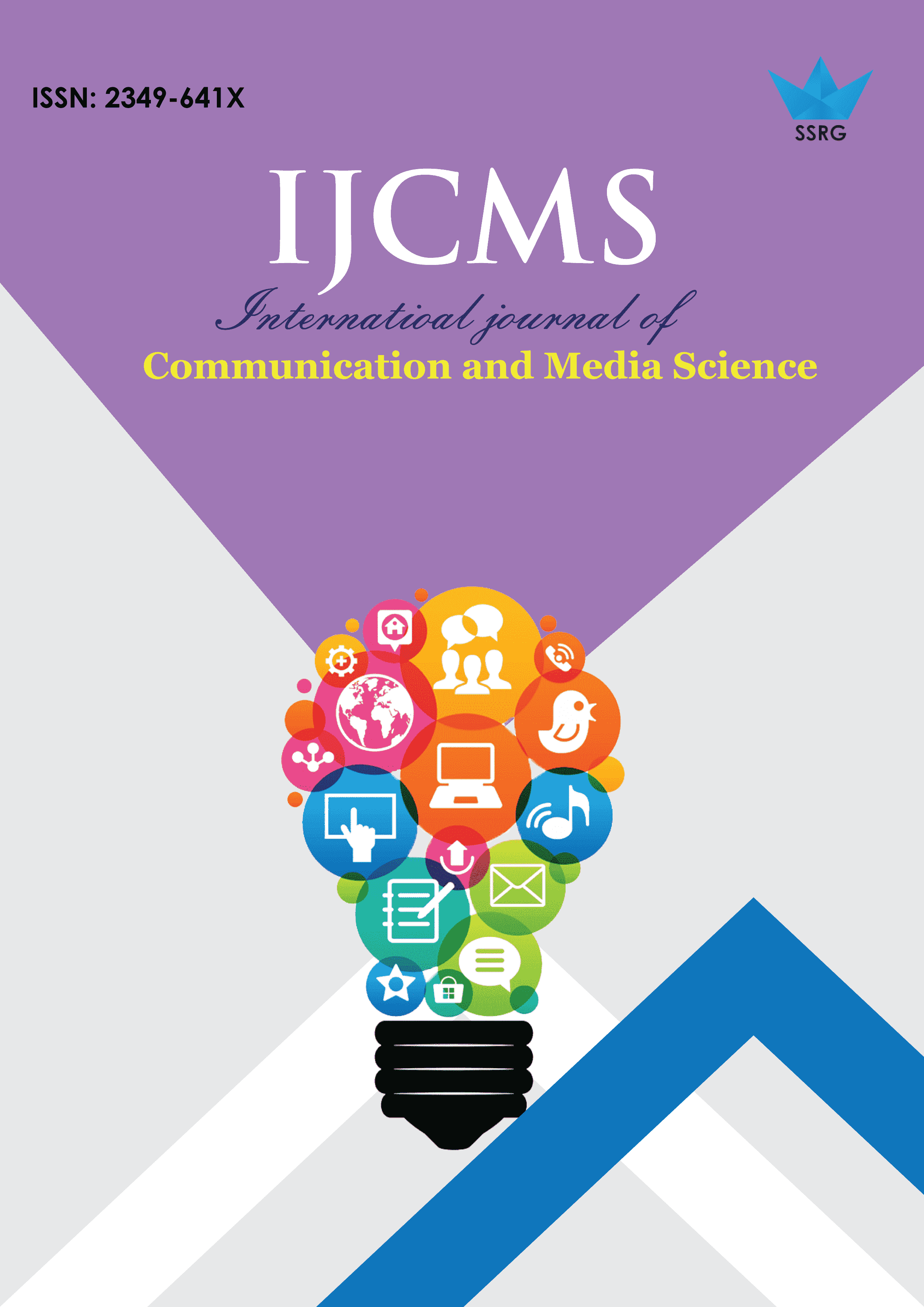A Study on Impact of Photography in Social Networks Users in Tamilnadu

| International Journal of Communication and Media Science |
| © 2014 by SSRG - IJCMS Journal |
| Volume 1 Issue 1 |
| Year of Publication : 2014 |
| Authors : L.Ganesh |
How to Cite?
L.Ganesh, "A Study on Impact of Photography in Social Networks Users in Tamilnadu," SSRG International Journal of Communication and Media Science, vol. 1, no. 1, pp. 1-5, 2014. Crossref, https://doi.org/10.14445/2349641X/IJCMS-V1I1P101
Abstract:
This research paper aims to look at the impact of photography in social networks users. This study was conducted to establish the kind of activities and sharing photography that leaner‟s performed on the social network and the length of time spent on the internet in order to evaluate the impact that these activities may have them. Using a sample of 300 learners from six areas in Tamil Nadu, only quantitative data were collected through the use of questionnaires. The result suggests that both a positive and negative impact of photography in social network users, the users engage in social networks and reveal their personal information to people they meet online further they keep strong relations with friends, to build up ties with new acquaintances and to a lesser time, to meet new people online. At the same time, sites like social networks allow them to exchange News Photography, Event Photography, Wildlife Photography and so many types of photography and discuss both public and private issues. It is the integration of these processes in concert with the relatively new opportunities provided by the internet and social media. The positive impact of photography in social network is that creates an environment in the cyber world.
Keywords:
Photography
References:
[1] Ball, D. (1999) “The ethics of digital manipulation; changing the photograph means changing the message” Retrieved October 3rd 2003 from http://www.highwayafrica.org.za/archive/1999/wednesday5.html
[2] Beverly Hills, CA. Katz, E., Gurevitch, M. & Haas, H. (1973) ‘On the use of mass media for important things’, American Sociological Review, vol. 38, no. 2, pp. 164–181.
[3] Berger, G (1999) “The digital manipulation debate: Africa challenging the dominant paradigm” Presented to Seminar on Ethics, Media Code of Practice and Journalism Training in Africa, Accra Ghana.
[4] Blumler, J. G. (1979) ‘The role of theory in uses and gratifications studies’,Communication Research, vol. 6, no. 1, pp. 9–36.
[5] Cass, T (1998) “A comparison of the views of South African and American Photojournalists to the digital manipulation of news photographs” Retrieved October 3rd 2003 from http://echea.ru.ac.za/search/aCass%2C+T/acass+t/1,4,5,B/frameset&FF=acass+taryn+may&1,1,
[6] Close H (2005) Roles and responsibilities in understanding, accepting and adapting in the chronic illness trajectory. Unpublished PhD thesis. Northumbria University.
[7] Harris, C. 1991 “Digitisation and Manipulation of News Photographs” Journal of Mass Media Ethics Lawrence Erlbaum Associates Inc. 164-174
[8] Heisley DD, Levy SJ (1991) Autodriving: a photoelicitation technique. Journal of Consumer Research. 18, 2, 257-272.
[9] Hurworth R (2003) Photo-interviewing for research. Social Research Update. Spring, 40, 1-4.
[10] Moran MJ, Tegano DW (2005) Moving toward visual literacy: photography as a language of teacher inquiry. Early Childhood Research and Practice. 7, 1, 1-20. http://ecrp. uiuc.edu/v7n1/moran.html [Last accessed: September 24 2007].
[11] Novak, D. R. (2010). "Democratizing Qualitative Research: Photovoice and the Study of Human Communication." Communication Methods & Measures 4(4): 291-310.
[12] Perkel, D. (2008). Copy and paste literacy? Literacy practices in the production of a Myspace profile. In K. Drotner, H. S. Jensen & K. C. Schroeder (Eds.), Informal learning and digital media: Constructions, contexts, consequences (pp. 203–224). Newcastle, UK: Cambridge Scholars Press.
[13] Phillips, D. (2008). The psychology of social media. Journal Of New Communications Research, 3(1), 79-85.
[14] Quan-Haase, A., & Young, A. L., 2010. Uses and gratifications of social media: A comparison of Facebook and Instant Messaging. Bulletin of Science, Technology & Society, 30(5), 350-361.
[15] Ruggiero, T. E. (2000) ‘Uses and gratifications theory in the 21st century’, Mass Communication & Society, vol. 3, no. 1, pp. 3–37.
[16] Smith, B. G. (2010). Socially distributing public relations: Twitter, Haiti, and interactivity in social media . Public Relations Review, 36, 329-335.
[17] Sweetser, K. D. (2011). A survey of social media use, motivation and leadership among public relations practitioners. Public Relations Review, 37, 425-428.
[18] Taylor, M. W. (2010). Anticipatory socialization in the use of social media in public 61 relations: Analysis of PRSA's public relations tactics . Public Relations Review, 36, 207-214.
[19] Toffler, A. (1980) The Third Wave: The Classic Study of Tomorrow, Bantam, New York.
[20] Wright, D., & Hinson, M. (2009). An analysis of the increasing impact of social and other new media on public relations practice. A paper presented to 12th annual International Public Relations Research Conference.

 10.14445/2349641X/IJCMS-V1I1P101
10.14445/2349641X/IJCMS-V1I1P101